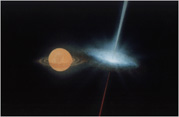Dec 18 2012
A remarkable observation by astronomers from the University of Southampton has been published in one of the world’s foremost astrophysics research journals.
 X-ray flash of XRF111111
X-ray flash of XRF111111
The research by Professor Phil Charles, Professor Malcolm Coe and postgraduate student Liz Bartlett has appeared in The Astrophysical Journal that is devoted to recent developments, discoveries, and theories in astronomy and astrophysics.
The Southampton Physics and Astronomy team are part of a global collaboration – with colleagues in Taiwan, South Africa, Poland, Australia and Italy - that has revealed that bright X-ray flares in nearby galaxies, once assumed to indicate the presence of black holes, can in fact be produced by white dwarfs.
They made the discovery by detecting a dramatic, short-lived X-ray flare that was picked up by an X-ray telescope on the International Space Station.
Using optical telescopes in South Africa and Chile, the Southampton astronomers showed that the flare, called XRF111111 as it happened on 11 November, 2011, was located in the Small Magellanic Cloud. These Magellanic Clouds are between 160,000 and 200,000 light years away and are the nearest satellite galaxies to the Milky Way. They are visible to the naked eye from the Southern Hemisphere.
The flare from XRF111111 was so luminous that astronomers initially thought it was likely to be a black hole producing X-rays but further research by Phil and his team revealed that its X-ray temperature was so low that it had to be a white dwarf instead.
White dwarfs are very common, burnt-out cinders of normal stars like the Sun that are typically about one solar mass but are contained in a volume no bigger than the Earth.
However, white dwarfs were not considered capable of producing such a huge X-ray flash but the optical observations in South Africa and Chile showed that the white dwarf was orbiting a hot B star - a normal star about 10 times the mass of our Sun that is much hotter and brighter. This was something that had only been seen twice previously and both times with much lower X-ray luminosities.
Research by Professor Charles and his team revealed that material was probably collecting on the surface of the white dwarf from the B star and eventually underwent runaway thermonuclear burning that was seen on Earth as a nova explosion.
Professor Charles says: “Our observations show that the thermonuclear burning probably caused a shell of matter to be ejected from around the white dwarf and when the shell hit the hot wind of the B star it produced a huge shock leading to the X-ray flash that was seen on the International Space Station.
“We think that this incredible X-ray flash was not due to accretion onto a black hole but was instead due to a nova explosion on a white dwarf that took place close to a hot massive star. This was something that we, as astronomers, have never seen before.
“This surprising result shows that, in the right circumstances, white dwarfs are capable of mimicking black holes, the most luminous objects we know of.”
A paper led by Ray Li, from the National Tsing Hua University, in Taiwan, describing these new results will appear in the 20 December issue of The Astrophysical Journal.